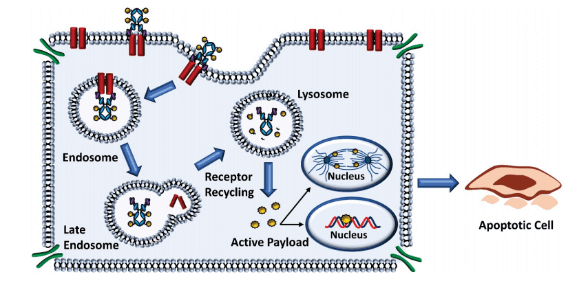What is antibody-drug conjugate (ADC)?
The structure of antibody-drug conjugate (ADC)
ADC consists of antibodies and payload, linker connects antibodies and small molecule drugs. After ADC drugs enter the blood, its antibody part will recognize and bind to the surface antigen of target cells. Theninternalizing ADC antigen complex into cells through endocytosis, the complex will be degraded by lysosomes and the payload will be released, so as to destroy DNA or microtubules, or exert the inhibitory effect of topoisomerase / RNA polymerase, resulting in cell death. It has the characteristics of precision and great lethality. It is a new generation of therapeutic drugs.1
Cellular Processing of antibody-drug conjugate (ADC)
ADC is composed of navigator targeting specific tumor cells and small molecules that can enter tumor cells to kill them, so how to maintain activity in blood to achieve good presentation effect is also a problem. Of course, accurate targeting can greatly reduce the sidekill effect. After ADC is swallowed into cells, lysosomal enzymes will hydrolyze the navigation of missiles (antibodies), thus releasing small cytotoxic molecules. Thus, it can block a series of activities in cells, including the transcription and translation of DNA and RNA. It can also block the transport of proteins by affecting tubulin. Finally, it can kill tumor cells. Therefore, here we need to pay attention to the consequences of Miss target and the loading of small molecules, which are potentially harmful to normal tissues and cells. The suspension of many clinical drugs in phase II and phase III is also greatly related to these two key points.
Figure 2. Cellular Processing of ADCs. Most ADCs undergo similar mechanisms to release the cytotoxic payload. In general, ADCs are designed for internalization and are processed via the endocytic pathway resulting in release of the payload and cytotoxic effect.2
How antibody-drug conjugate (ADC) work? Mechanisms of action (MOA) for ADC
The drugs in ADC can recognize the membrane proteins of tumor cells, then locate the target cells. After endocytosis into cells, lysosomes hydrolyze and release small molecules in ADC. For example, VCMMAE is an anti-mitotic agent in antibody coupled drugs (ADC). It is crosslinked by monomethylalistatin e (MMAE) and dipeptide valine citrulline (VC). VCMMAE is a powerful anti-mitotic agent by blocking tubulin polymerization. VCMMAE effectively resist mitosis and kill cells by blocking tubulin polymerization. Microtubules play an important role in cell function, participate in migration, transportation and recombination, and have many dynamic roles, including the movement of motor proteins and the separation of chromosomes during cell division.Reference:
1. Su Z , Xiao D , Xie F , et al. Antibodydrug conjugates: Recent advances in linker chemistry[J]. Acta Pharmaceutica Sinica B, 2021.
2. Dean AQ, Luo S, Twomey JD, Zhang B. Targeting cancer with antibody-drug conjugates: Promises and challenges. MAbs. 2021 Jan-Dec;13(1):1951427. doi: 10.1080/19420862.2021.1951427. Erratum in: MAbs. 2021 Jan-Dec;13(1):1966993. PMID: 34291723; PMCID: PMC8300931.






 View the Knowledge base of Antibody-drug Conjugate (ADC)
View the Knowledge base of Antibody-drug Conjugate (ADC)